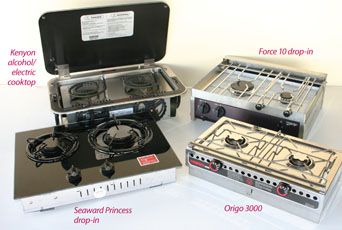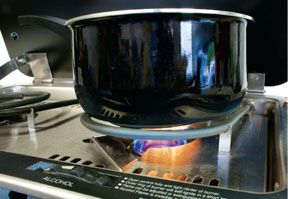While liveaboards may opt for the comfort of shore-style cooking with a stove/oven combo, small-boaters often just don’t have the space-or need-to accommodate such a luxury. Enter the two-burner cooktop.

342
Double-burners save time and are more versatile than their single-burner counterparts, which PS reviewed in the July 2006 issue. They make cooking aboard less arduous, and if theres anyone on a boat you want to keep happy, its the cook.
As Lin Pardey put it in “The Care and Feeding of the Offshore Crew,” the cruising cooks bible: “If cooking isn’t easy and enjoyable, neither is cruising…and the most important tool the cook uses is the stove.”
What We Tested
The test field included two propane stoves: the Force 10 drop-in cooktop (Model 60100) and the Seaward Princess drop-in (Model 2277). Also tested was the Origo 3000, big sister to the single-burner Origo 1500 that PS recommended in the July issue. The only dual-heat-source stove tested was the Kenyon alcohol/electric cooktop. Origo makes a similar model. Another Seaward two-burner was not received in time for the test, so look for its review in a future PS issue.
Neither the Kenyon nor the Seaward Princess is gimbaled. The Force 10 and Origo can be gimbaled and come with pot holders, an American Boat and Yacht Council (ABYC) requirement for galley stoves.
The ABYC also requires that gaseous stoves with fuel sources weighing more than 8 ounces have an automatic flame failure shutoff, so that in the event the flame is blown out, the fuel flow is stopped. Both the Force 10 and the Seaward have this feature, and both functioned well; the Origo and the Kenyon are not required to because they are not gaseous stoves.
How We Tested
The boil-test venue change resulted in a dramatic difference in boil time for the Origo. The single-burner Origo 1500 clocked in at 11 minutes, 20 seconds outdoors, while the Origo 3000 boiled the water in 5 minutes, 46 seconds indoors.
All stoves were evaluated on quality of construction; features like spill-pan depth, pot holders, and control-knob ergonomics; and compliance with the ABYC standards.
To test ease of cleaning, testers spattered warm instant oatmeal-we opted for brown sugar-flavored this time-on the stoves, let the burners toast it to a crusty goo, and left it to harden. Two days later, testers cleaned, first with just soap and water on a non-abrasive sponge, and then with oven cleaner.
Force 10 Drop-in Cooktop
Adjustable pot holders allow the cook to use nearly any size pot or pan. They attach at the front or sides of the stove, keeping the users hands away from the open flame.
One feature testers particularly like about the Force 10 is the knobs flame-off position: The low-flame setting is at the bottom of the control knob and flame-off is at the top, making the turnoff action noticeable and making it difficult to accidentally extinguish the flame while simmering.
Gimbals with brass locks allow the stove to be safely used whether at sea or in port. A deep spill pan that covers most of the stoves surface will help keep those galley floors clean.
The caked-on, burnt-on oatmeal wiped right off the stoves spill pan area once the grate was removed, but oven cleaner and some elbow grease were required to get the goo off the grate and burners. The burner-face caps are affixed with two screws, but they can be easily removed for cleaning, and the screws keep them from rattling. The caps are made of ceramic-coated steel, and although theyre protected by the stainless grate, the coating will chip if handled roughly, which could lead to rusty burner caps. According to Force 10, these will have to be replaced eventually, but customers have the choice of upgrading to a solid stainless cap.
Propane galley systems can be self-installed, but they must be put in carefully and thoughtfully, and Force 10 provides excellent instructions. The ABYC has many guidelines for installation, and they are worth a read (www.abycinc.org) if you plan to install a propane stove.
The Force 10 line of propane and electric stoves and ranges-including this model but not the Force 10 Seacook PS reviewed in July-was recently sold to ENO, a leading maker of galley equipment in Europe. Force 10, now a subsidiary of ENO, will continue to design, manufacture, and ship the stove products.
Bottom Line: At $470, its the most expensive stove of the group, but its seaworthiness and features make it worth the money, in our opinion. It gets Best Choice honors.
Kenyon Alcohol/Electric Combo

288
Typical of alcohol stoves, the Kenyon was a bit lethargic in the boil test. The stove boiled water from a cold start in 11 minutes, 45 seconds-the slowest of the test stoves. The temperature control knobs-dials set along the front and sides of the cooktop that open and close the alcohol chimney covers-were stiff and awkward, in PSs opinion.
Testers rated the Kenyons spill pan Excellent as it covers most of stove top. The electric burners, which serve as burner grates for alcohol cooking, flip up and out of the way for cleaning. The stovetop is easy to clean, but users would do well to remember to keep the alcohol chimney closed while cleaning to avoid water and debris getting on the wick.
Testers are not fond of the Kenyons tempered-glass cover. The glass can and will shatter when overheated; however, shutting the lid automatically stops fuel flow to avoid such a danger from happening. The lid does not latch shut, but it has rubber feet to reduce rattling underway. The warranty does not cover damage to the glass; to replace a chipped or broken lid costs about $145, Williams said.
Bottom Line: The Kenyon offers the unique flexibility of two heat sources. If youre planning to do most of your cooking at a dock, this may be a good option.
Origo 3000
It can be gimbaled or mounted and has front-mount, adjustable pot holders. The spill pans are too shallow, in our opinion, but the grates are easy to remove, and the stovetop is easy to clean. The only noticeable corrosion was on the alcohol chimney diffuser, and Origo will replace that part free.
Despite the fact that alcohol heats up more slowly than LPG, the 3000 was a contender in this boil test. Unlike the Kenyons alcohol system that involves self-priming and fuel jets, the Origo uses the basic pan of alcohol and a fiber wick; the wick soaks up the fuel, and when lit, it heats the burner.
Perhaps the best feature of the Origo is that, unlike any other test stove, an oven can be added later. By adding the Origo 6200 oven with four screws to the 3000, customers will have a two-burner stove/oven without having to buy and install a whole new kit-and-kaboodle.
Bottom Line: Although the 3000 carries with it all the issues of alcohol cooking-slower burning than gas, fuel odor, etc.-it offers features other test stoves don’t and its roughly $150 cheaper than the rest of the pack, making it the PS Budget Buy. The 3000 is especially a good choice for boaters who don’t want to fool with installing a propane or electric system, or properly maintaining the system by conducting regular checks.
Seaward Princess Cooktop
Seaward advertises pot holders for this cooktop (sold separately), but the company did not supply PS with any for testing. The stoves spill pans are quite shallow, making cooking liquid foods underway less than tempting.
The two-step electric ignition (push and hold) is powered by a 12-volt hookup (standard) or a 9-volt battery.
Bottom Line: This stove is attractive, but less practical than others in its price range.
Conclusions
Force 10, our Best Choice, is a fast-cooking, quality stove that meets ABYC standards. Taking Budget Buy honors, the Origo 3000 is nearly $150 cheaper with more features than the Kenyon and Seaward Princess.
Contacts
Force 10, 800/663-8515, www.force10.com/
Kenyon, 860/664-4906, www.kenyonappliances.com/
Origo, 941/355-4488, +46 35/16-5700, www.origo-sweden.com/
Seaward Princess, 562/699-7997, www.seawardproducts.com/





































Do you know of installation samples of the Zeno 2 burner gimbaled stove, no oven